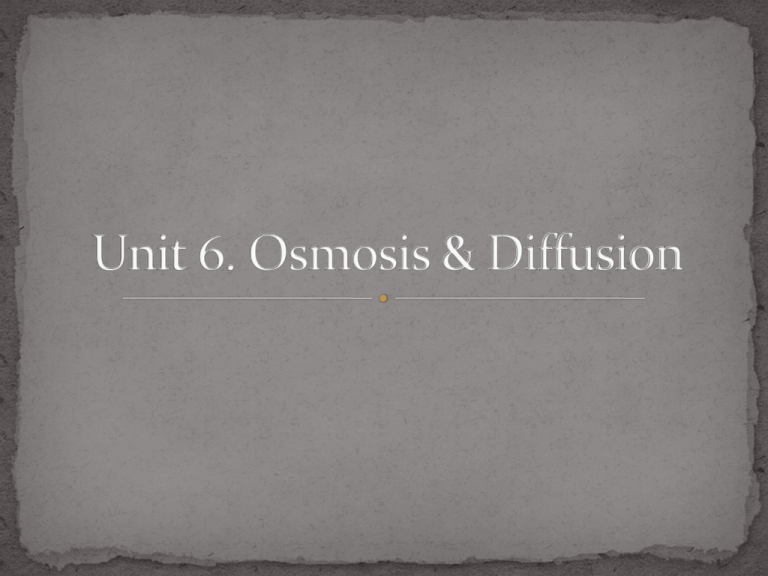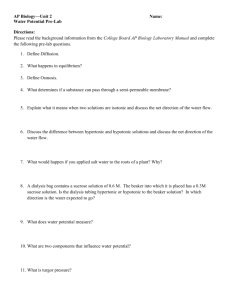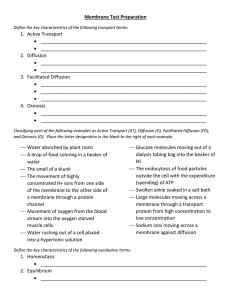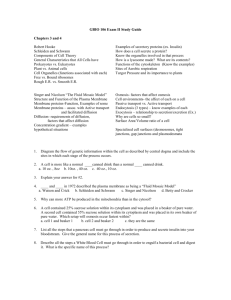Slides on Osmosis and Diffusion
advertisement

Diffusion is the movement of any molecule from an area of higher concentration to one of a lower concentration (concentration gradient) through a solid, liquid or gas. A drop of food coloring put in a glass of water will diffuse at a constant rate until the concentration of colorant is equal in all the water. The perfume of a flower, which are none other than chemical molecules, move through the air by diffusion at a constant rate until the whole room smells like the flower. Mercury can diffuse through your skin and cause toxic effects in your nervous system. Osmosis is a specialized type of diffusion. It is the diffusion of water molecules across a selectively permeable membrane. If you leave the celery out of the fridge for a few hours, it becomes wilted. If you submerge it in water for a few hours it regains its crisp consistency. That is due to water moving into the cell by osmosis. 2 When comparing the concentration of solutes in different solutions, the terms hypotonic, hypertonic and isotonic are used. A solution consists of solute(s) + solvent. Lemonade lemon juice + sugar (solutes) water (solvent) 3 Hypotonic Isotonic Hypertonic (lower than) (equal to) (higher than) Hypotonic Water concentration outside is higher than that inside the cell, the water moves inside the cell. Isotonic Water concentration is equal in and out of cell. There is no net movement. Hypertonic Water concentration is lower outside the cell, the water moves outside the cell. 4 Higher temperatures tend to increase the rate of diffusion. 2 agar plates are prepared. Two holes are made in each of the agar plates. One plate will be kept at room temperature (25˚C) One plate will be put in the incubator at 37˚C Potassium Permanganate (294 Daltons) Janus Green (511 Daltons) In both plates, each well is filled with a solution and both plates are kept at it’s required temperature for 30 minutes 5 Potassium Permanganate Janus green Results: n0 diffusion on both Time: 0 minutes Potassium permanganate Janus green 21 mm 15 mm Time: 30 minutes The diameter of the diffusion in each one of the dyes was measured by the distance from edge to edge. 6 Potassium permanganate Janus green 0 diffusion on both 0 minutes Potassium permanganate 17 mm Janus green 14 mm 30 minutes Conclusions: 1. The lower the temperature, the slower the rate of diffusion. 2. The higher the molecular weight, the lower the rate of diffusion. 7 Dialysis tubing is a semi-permeable material that can be used to simulate the movement of substances through cell membranes (cell membranes are selectively permeable). The pores on the dialysis tubing are large enough to allow water molecules, other small molecules and ions to move through unrestricted. Larger molecules, such as sucrose, cannot cross because of their size. Roll of dialysis tubing 8 A 12 cm piece of tubing was cut and filled with a solution. The ends were tied with string. The resulting bag represents a cell. The bag is then placed in a beaker and the contents of beaker represent the environment that surrounds cells. Bag of solution Bag in beaker with solution 9 3 bags were prepared according to the information on the table below. 3 beakers were prepared according to the information given below. The bags were placed in the beakers and left for 40 minutes. 1 N° Bag contents Beaker contents 1 10 ml 10% sucrose 200 ml dH2O 2 10 ml dH2O 200 ml 10% sucrose 3 10 ml 10% sucrose 200 ml 10% sucrose 2 3 10 N° Bag contents Beaker contents Weight change 1 10 ml 10% sucrose 200 ml dH2O + 5.65 grams 2 10 ml dH2O 200 ml 10% sucrose - 4.89 grams 3 10 ml 10% sucrose 200 ml 10% sucrose no change Conclusions: Water will move from high concentration of water to areas of lower concentration. 11 The solution contains a mixture of starch, protein, sodium chloride, and sodium sulfate in an aqueous solution. Starch and protein are both macromolecules. Sodium chloride (NaCl), will dissociate in an aqueous solution to produce sodium ion (Na+) and chloride ion (Cl -). Sodium sulfate (Na2SO4) will dissociate in an aqueous solution to produce sodium ion (Na+) and sulfate ion (SO4⁻²). Dialysis tubing is a material that will be used to simulate differentially permeability of membranes. Only molecules and ions smaller than the pores of the tubing will be allowed to cross. 12 The flask contains starch, protein, sodium chloride, and sodium sulfate in an aqueous solution. A bag is prepared containing this cocktail. The bag is then placed in a beaker of distilled water for 40 minutes. 13 Tests for the presence of: Starch with iodine + - Protein with Biuret + - Chloride ions with silver nitrate (AgNO3) Sulfate ions with barium chloride (BaCl2) + - NOTE: It is difficult to see the white precipitate in this last case. You have something resembling chalk dust collecting at the bottom of the test tube. You may need to shake the tube. + 14 After 40 minutes these were the results of the experiment: Tube 1: test for starch Tube 2: test for protein Tube 3: test for chloride ions Tube 4: test for sulfate ions 1 2 3 4 Conclusions: Only sulfate and chloride ions are small enough to go through the pores of the membrane. - - + + 15 Water flows across membranes unrestricted. It flows from a region of lower solute concentration to a region of higher solute concentration until equilibrium is established. Plant cells have cell walls which support the cell and keep it from osmotic shock. Animal cells do not have cell walls and may rupture unless they have a mechanism for stabilizing the osmotic differences. 16 These test tubes contain 4 drops of sheep blood in a saline solution. Tube A contains 10% NaCl solution (hypertonic solution). Tube B contains 0.9% NaCl solution (tonicity similar to that of blood plasma, isotonic solution). Tube C contains 0.45% NaCl solution (hypotonic solution). A B C hyper tonic isotonic hypotonic 17 Notice the crenation shown by the membrane collapsing due to loss of water. 100x 18 Notice the round and smooth shape the red blood cells show in this picture. 40x 19 Very few or no cells are 40x seen in this condition as water flows in causing the bursting of the cells. 20 Two beakers have been prepared and Elodea (an aquarium plant) has been placed in each of the beakers. Beaker A contains 0% NaCl solution (hypotonic solution). Beaker B contains 20% NaCl solution (hypertonic solution). A B 21 chloroplasts vacuole Normal turgid cell in a hypotonic solution. Water moves into the cells, chloroplasts are pushed to the sides due to the enlarged central vacuole where water is stored. A 22 Plasmolyzed cells are present due to the hypertonic condition that makes the water move outside the cell, causing the membrane to collapse. It is characteristic to see the chloroplasts clumped in the center of the cell, with the membrane surrounding them. Cell membrane End B Clumped chloroplasts 23





